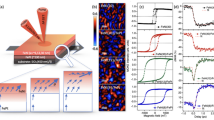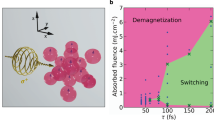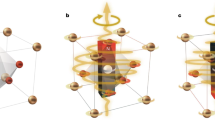Abstract
The magneto-optical Kerr effect (MOKE) is a powerful tool for studying changes in the magnetization of ferromagnetic materials. It works by measuring changes in the polarization of reflected light. However, because the conventional theoretical basis for interpreting a MOKE signal assumes measurement with continuous-wave light1,2, its use for understanding high-speed magnetization dynamics of a material probed with femtosecond optical pulses3,4 has been controversial5,6,7,8,9,10. Here we establish a new paradigm for interpreting time-resolved MOKE measurements, through a first-principles investigation of ferromagnetic nickel. We show that the time-resolved optical and magnetic responses energetically follow their respective optical and magneto-optical susceptibilities. As a result, the one-to-one correspondence between them sensitively depends on the incident photon energy. In nickel, for photon energies below 2 eV the magnetic response is faithfully reflected in the optical response, but above 2 eV they decouple. By constructing a phase-sensitive polarization versus magnetization plot, we find that for short pulses the magnetic signals are delayed by 10 fs with respect to the optical signals. For longer pulses, the delay shortens and the behaviour approaches the continuous-wave response. This finally resolves the long-standing dispute over the interpretation in the time-resolved MOKE measurements and lays a solid foundation for understanding femtomagnetism3,4.
This is a preview of subscription content, access via your institution
Access options
Subscribe to this journal
Receive 12 print issues and online access
$259.00 per year
only $21.58 per issue
Buy this article
- Purchase on SpringerLink
- Instant access to full article PDF
Prices may be subject to local taxes which are calculated during checkout



Similar content being viewed by others
References
Argyres, P. N. Theory of the Faraday and Kerr effects in ferromagnetics. Phys. Rev. 97, 334–345 (1955).
Erskine, J. L. & Stern, E. A. Magneto-optic Kerr effects in gadolinium. Phys. Rev. B 8, 1239–1255 (1973).
Beaurepaire, E., Merle, J.-C., Daunois, A. & Bigot, J.-Y. Ultrafast spin dynamics in ferromagnetic nickel. Phys. Rev. Lett. 76, 4250–4253 (1996).
Zhang, G. P., Hübner, W., Beaurepaire, E. & Bigot, J.-Y. Laser-induced ultrafast demagnetization: Femtomagnetism, a new frontier? Topics Appl. Phys. 83, 245–289 (2002).
Koopmans, B., van Kampen, M., Kohlhepp, J. T. & de Jonge, W. J. M. Ultrafast magneto-optics in nickel: Magnetism or optics? Phys. Rev. Lett. 85, 844–847 (2000).
Guidoni, L., Beaurepaire, E. & Bigot, J.-Y. Magneto-optics in the ultrafast regime: Thermalization of spin populations in ferromagnetic films. Phys. Rev. Lett. 89, 017401 (2002).
Bigot, J.-Y., Guidoni, L., Beaurepaire, E. & Saeta, P. N. Femtosecond spectrotemporal magneto-optics. Phys. Rev. Lett. 93, 077401 (2004).
Wilks, R. et al. Investigation of ultrafast demagnetization and cubic optical nonlinearity of Ni in the polar geometry. J. Appl. Phys. 95, 7441–7443 (2004).
Comin, A., Rossi, M., Mozzati, C., Parmigiani, F. & Banfi, G. P. Femtosecond dynamics of Co thin films on Si support. Solid State Commun. 129, 227–231 (2004).
Stamm, C. et al. Femtosecond modification of electron localization and transfer of angular momentum in nickel. Nature Mater. 6, 740–743 (2007).
Stanciu, C. D. et al. All-optical magnetic recording with circularly polarized light. Phys. Rev. Lett. 99, 047601 (2007).
Zhang, G. P. & Hübner, W. Laser-induced ultrafast demagnetization in ferromagnetic metals. Phys. Rev. Lett. 85, 3025–3028 (2000).
Lefkidis, G. & Hübner, W. First-principles study of ultrafast magneto-optical switching in NiO. Phys. Rev. B 76, 014418 (2007).
Gomez-Abal, R., Ney, O., Satitkovitchai, K. & Hübner, W. All-optical subpicosecond magnetic switching in NiO(001). Phys. Rev. Lett. 92, 227402 (2004).
Hohlfeld, J., Matthias, E., Knorren, R. & Bennemann, K. H. Nonequilibrium magnetization dynamics of nickel. Phys. Rev. Lett. 78, 4861–4864 (1997); erratum 79, 960–960 (1997).
Regensburger, H., Vollmer, R. & Kirschner, J. Time-resolved magnetization-induced second-harmonic generation from the Ni(110) surface. Phys. Rev. B 61, 14716–14722 (2000).
Malinowski, G. et al. Control of speed and efficiency of ultrafast demagnetization by direct transfer of spin angular momentum. Nature Phys. 4, 855–858 (2008).
Radu, I. et al. Laser-induced magnetization dynamics of lanthanide-doped permalloy thin films. Phys. Rev. Lett. 102, 117201 (2009).
Kurkin, M. I., Bakulina, N. B. & Pisarev, R. V. Transient inverse Faraday effect and ultrafast optical switching of magnetization. Phys. Rev. B 78, 134430 (2008).
Hübner, W. & Zhang, G. P. Ultrafast spin dynamics in nickel. Phys. Rev. B 58, R5920–R5923 (1998).
Oppeneer, P. M. & Liebsch, A. Ultrafast demagnetization in Ni: Theory of magneto-optics for non-equilibrium electron distributions. J. Phys. Condens. Matter 16, 5519–5530 (2004).
Vernes, A. & Weinberger, P. Formally linear response theory of pump–probe experiments. Phys. Rev. B 71, 165108 (2005).
Zhang, G. P. Laser-induced orbital and spin excitations in ferromagnets: Insights from a two-level system. Phys. Rev. Lett. 101, 187203 (2008).
Zhang, G. P. & George, T. F. Total angular momentum conservation in laser-induced femtosecond magnetism. Phys. Rev. B 78, 052407 (2008).
Zhang, G. P., Bai, Y., Hübner, W., Lefkidis, G. & George, T. F. Understanding laser-induced ultrafast magnetization in ferromagnets: First-principles investigation. J. Appl. Phys. 103, 07B113 (2008).
Bai, Y. & Ward, R. C. Parallel block-tridiagonalization of real symmetric matrices. J. Parallel. Distrib. Comput. 68, 703–715 (2008).
Blaha, P., Schwarz, K., Madsen, G. K. H., Kvasnicka, D. & Luitz, J. WIEN2k, An Augmented Plane Wave + Local Orbitals Program for Calculating Crystal Properties (Karlheinz Schwarz, Techn. Universität Wien, 2001).
Kampfrath, T. et al. Ultrafast magneto-optical response of iron thin films. Phys. Rev. B 65, 104429 (2002).
Ogasawara, T. et al. Photoinduced spin dynamics in La0.6Sr0.4MnO3 observed by time-resolved magneto-optical Kerr spectroscopy. Phys. Rev. B 68, 180407(R) (2003).
Bigot, J.-Y. Femtosecond magneto-optical processes in metals. C. R. Acad. Sci. Paris, t. Sèrie IV 2, 1483–1504 (2001).
Acknowledgements
This work was supported by the US Department of Energy under contract No DE-FG02-06ER46304 and US Army Research Office under contract W911NF-04-1-0383, and was also supported by a Promising Scholars grant from Indiana State University. In addition, we acknowledge part of the work as done on Indiana State University’s high performance computers. This research used resources of the National Energy Research Scientific Computing Center, which is supported by the Office of Science of the US Department of Energy under contract No DE-AC02-05CH11231. W.H. and G.L. acknowledge support from Priority Programmes 1133 and 1153 of the German Research Foundation. Initial studies used resources of the Argonne Leadership Computing Facility at Argonne National Laboratory, which is supported by the Office of Science of the US Department of Energy under contract No DE-AC02-06CH11357.
Author information
Authors and Affiliations
Contributions
G.P.Z. drafted the paper, and W.H., G.L., Y.B. and T.F.G. modified it. G.P.Z. computed the results, and G.P.Z., W.H. and G.L. analysed the data. Y.B. implemented the parallelization of the source code.
Corresponding author
Supplementary information
Supplementary Information
Supplementary Information (PDF 223 kb)
Rights and permissions
About this article
Cite this article
Zhang, G., Hübner, W., Lefkidis, G. et al. Paradigm of the time-resolved magneto-optical Kerr effect for femtosecond magnetism. Nature Phys 5, 499–502 (2009). https://doi.org/10.1038/nphys1315
Received:
Accepted:
Published:
Issue date:
DOI: https://doi.org/10.1038/nphys1315
This article is cited by
-
Quasi-static strain governing ultrafast spin dynamics
Communications Physics (2022)
-
Ultrafast laser induced local magnetization dynamics in Heusler compounds
Scientific Reports (2016)
-
Optically switched magnetism in photovoltaic perovskite CH3NH3(Mn:Pb)I3
Nature Communications (2016)
-
Ultrafast spin dynamics and switching via spin transfer torque in antiferromagnets with weak ferromagnetism
Scientific Reports (2016)
-
Coherent ultrafast spin-dynamics probed in three dimensional topological insulators
Scientific Reports (2015)



